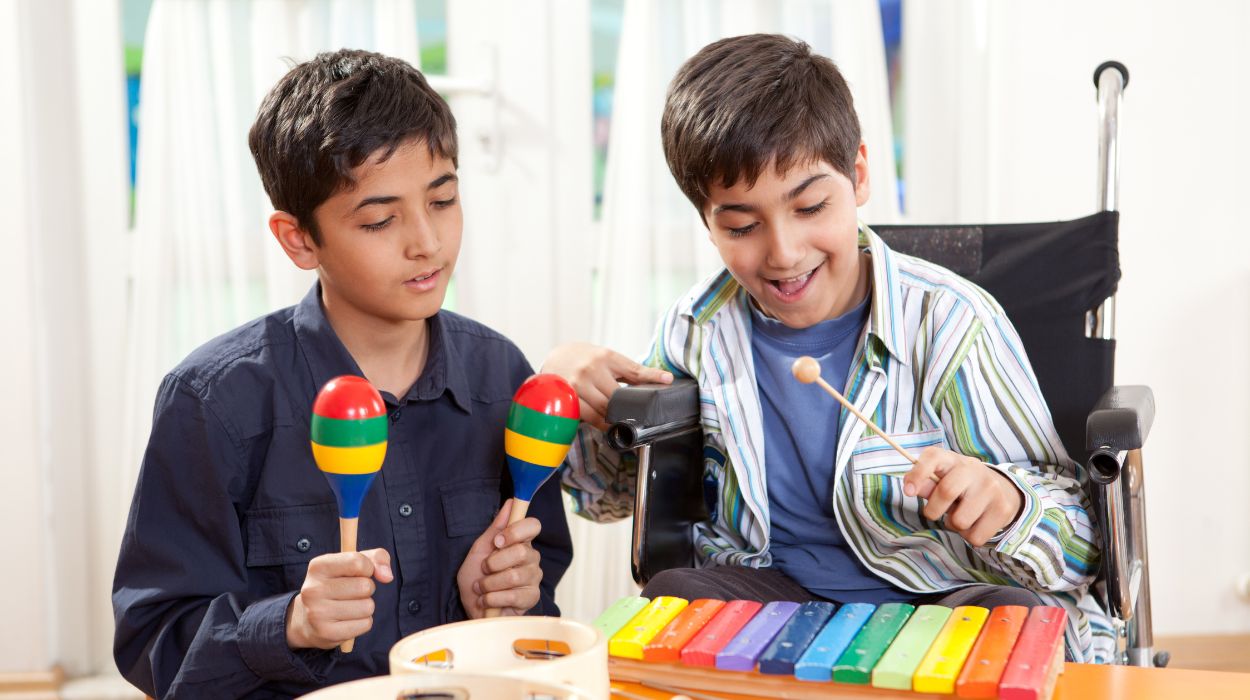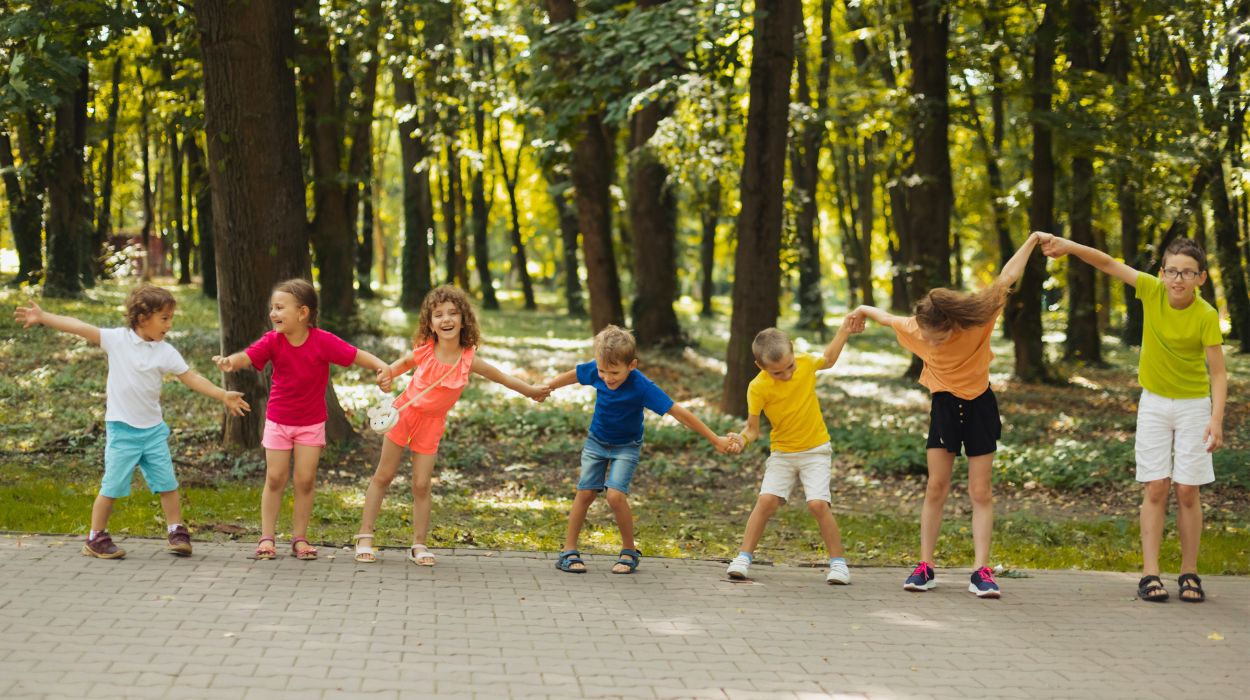 Expert's opinion
Expert's opinion
Expert's opinion
The article is a subjective view on this topic written by writers specializing in medical writing.
It may reflect on a personal journey surrounding struggles with an illness or medical condition, involve product comparisons, diet considerations, or other health-related opinions.
Although the view is entirely that of the writer, it is based on academic experiences and scientific research they have conducted; it is fact-checked by a team of degreed medical experts, and validated by sources attached to the article.
The numbers in parenthesis (1,2,3) will take you to clickable links to related scientific papers.
Activities For Children With Autism: Top Fun Activities In 2024

Autism spectrum disorder, ASD is a condition characterized by challenges in social interaction and communication, along with engagement in repetitive behavior. Participating in activities plays a crucial role[1] in child development. Activities for children with autism positively affect[2] social and communication skills.
Alongside treatments for autism, such as therapy, different types of activities offer unique benefits. Children with autism are less likely to participate in activities[3] because their senses can become overwhelmed. Music therapy and outdoor play are a few ideas for autistic kids to allow them to get involved in a way that’s suitable for them.
Best Activities For Autistic Kids
The best play and activities for autistic kids support their social and cognitive development. It’s important to consider your child’s needs to get the most out of activities. Assess your child’s special interests, and make sure your sessions are structured well. Don’t hesitate to contact an occupational therapist if you feel you need help. The best activities for autistic kids include:
- Music therapy.
- Outdoor play.
- Board games and puzzles.
- Animal-based activities.
- Technology-based activities.
Why Play Is Important For Kids With Autism
Play offers kids more than entertainment. It gives them a chance to encounter and understand the world.[4] This simple act helps to strengthen the developing brain.[5] Every child with autism is unique. There’s a diverse range of play activities for kids with autism.
Many of these options help to promote healthy growth[6] and development, problem-solving skills, and self-expression. Play sessions can vary in their structure. Self-directed play gives children free rein. In contrast, specific activities help to direct a child’s focus toward a certain goal or outcome.
The Benefits Of Activities For Individuals With Autism
Carefully selected and frequent autism activities help to enrich[6] social, cognitive, and emotional abilities. They’re beneficial for physical and mental health. As you’ve read, play isn’t a means to keep your child occupied. Autistic activities are vital to mental and physical well-being.
Specific autistic activities expose a child to a range of different experiences. These include time spent in nature, music, animals, and games. Some activities are more mentally-stimulating and center around language and problem-solving, Others are physical and enhance social skills[7] and behavior.
Great Activities For Autistic Kids
In a world of screens and apps, it’s easy to settle for digital options. While these can be helpful, there are also plenty of real-world sensory activities for children that are equally enjoyable and beneficial. Explore some of the best sensory activities for autism below. These autism activities include:
- Music therapy
- Outdoor play
- Board games and puzzles
- Animal-based activities
- Technology-based activities
Music Therapy

As an allied health profession, music therapy helps children learn and refine cognitive, behavioral, and social functions. Music stimulates the senses of children and motivates them. Music therapy sessions help children to socialize,[8] communicate, and express themselves. Experiencing a variety of musical instruments can add dimension to recreational programs.
Research shows that music therapy makes for a great autism activity. It fosters social interaction[9] and verbal communication in autistic kids. Music therapy also enhances new skills, such as non-verbal communication and social adaptation skills.
Playing music or singing to your autistic baby also offers several benefits. Singing helps children learn and understand language[10] and to recognize musical melodies.
Outdoor Play

Simply stepping outdoors can change our mood. Chemicals found in forest air can influence the brain[11] in special ways. In animal studies, touching soil exposes us to microbes that shield us against stress[12] in animal studies. These facts make the outdoors a perfect place for recreational activities and developing social skills.
Outdoor play also makes a great option for daily activities for autistic children. Running, jumping, swimming, and climbing are great exercises for autistic kids. Outdoor play exposes them to challenging situations and imaginative play, which they tend to enjoy.[13]
Activities such as the Buddy Game[14] use songs and movement to promote social interaction that will contribute to your child’s development.
Board Games And Puzzles

When choosing an activity, you should consider what not to do with an autistic child. Board games and puzzles are sometimes complicated. Use them as an opportunity to play and don’t apply too much pressure.
Linear board games are especially helpful for children with autism. These include checkers, chutes and ladders, and Monopoly. Linear board games support math skills[15] in kids with autism.
Puzzle games help to inspire autistic kids and boost their attention span.
The puzzle hunt game[16] combines social interaction, physical activity, and problem-solving.
Animal-Based Activities

Autistic kids sometimes find it hard to get along with other children. This can lead to feelings of anxiety and problem behaviors.[17] Interestingly, some autistic children seek out the companionship of animals and sometimes benefit from them.
Animal-assisted activities aim to increase social behavior in autistic kids. Animals help children to step outside of their boundaries and interact with others. Research shows that the presence of guinea pigs in a classroom setting helped to improve the social functioning[17] of autistic children.
This form of therapy uses a wide range of animals.[18] Approaches include dogs, horses, and even dolphins.
Technology-Based Activities

We live in a virtual age. Much of our learning, entertainment, and communication revolves around technology. Technology can negatively impact[19] the social skills and relationships of children. However, certain technologies are excellent therapeutic tools[20] for children with autism.
Various apps, games, and educational tools make for great indoor activities for an autistic child. These digital tools help autistic children to communicate and make decisions comfortably.[21] They also help to develop social networking.
Newer technologies, including virtual reality and augmented reality, and online counseling for kids show promise in teaching both social and practical skills.[22]
How To Choose The Right Activities For Kids With Autism
Autistic children share the same disorder. However, they are all unique individuals. Every autistic kid has their own interests and things that make them feel uncomfortable. As a parent, you’ll know your own children.
If you are working with kids, you’ll need to get to know their likes and dislikes before choosing activities. Consider the key points below when choosing the right activities for autistic kids.
Assess Their Interests
Autistic kids tend to develop strong special interests[23] in certain topics. Their passion for things can wax and wane. Sometimes, though, they can take their interest into adulthood and even employment.
Focusing on their interests can also help autistic children to socialize and express themselves better. After identifying their interests, think of ways to add them to games, activities, and learning experiences.
Consider Sensory Play
Autistic children sometimes experience problems with sensory processing[24] and body awareness. These kids struggle with loud and hectic environments, reading body language, interpreting facial expressions, and understanding tone of voice. Sensory play provides stimulation in a controlled way. They may meet the special needs of one child but not offer much benefit to others.
If your child appears to benefit from sensory play, you have plenty of activities.
Sensory play includes playing with colored beans and bathing in glowing water. Playing with rainbow soap foam and zipper boards is also a fun option to explore alone or with others.
Start With Structure
Routine and structure[25] are important for many children with autism. They display repetitive behaviors[26] and a desire for sameness. Try to structure activities well while still giving the child room to develop and move forward. You can support autistic children by using structured play.
Try to keep sessions the same length and select activities that your child can do without becoming too frustrated. Eventually, you can expand the length of play sessions and slowly introduce new activities.
Gradually Introduce New Activities
While the structure is essential during autism activities, introducing new activities will stimulate your child. It will also allow them to grow and become comfortable with new forms of stimulation.
Start off by introducing activities that have similarities to their favorite games. Gradually introduce variations of particular games at a pace that’s comfortable for them.
Seek Professional Guidance
You’re not in this alone. If you need help identifying your child’s areas of interest, seek professional help. Occupational therapists and behavioral therapists can help you during this process.
Their specialized knowledge and experience with autistic children are invaluable. They can suggest activities that target specific goals and contribute to overall well-being.
Conclusion
Children with autism often have trouble socializing and making friends. However, they depend on play and activities for mental and physical development.
There is a range of evidence-based activities that can help to grow their cognitive and behavioral abilities. These include outdoor play, animal-based activities, and music therapy.
Keep play sessions structured and gradually introduce new games and activities. Assess their interests, and don’t hesitate to contact an occupational or behavioral therapist if needed.
+ 26 sources
Health Canal avoids using tertiary references. We have strict sourcing guidelines and rely on peer-reviewed studies, academic researches from medical associations and institutions. To ensure the accuracy of articles in Health Canal, you can read more about the editorial process here
- Center on the Developing Child at Harvard University. (2020). Activities Guide: Enhancing & Practicing Executive Function Skills. [online] Available at: https://developingchild.harvard.edu/resources/activities-guide-enhancing-and-practicing-executive-function-skills-with-children-from-infancy-to-adolescence/.
- Huang, J.-F., Du, C., Liu, J.-J. and Tan, G.-X. (2020). Meta-Analysis on Intervention Effects of Physical Activities on Children and Adolescents with Autism. [online] 17(6), pp.1950–1950. doi:https://doi.org/10.3390/ijerph17061950.
- Little, L., Ausderau, K., Sideris, J. and Baranek, G.T. (2015). Activity Participation and Sensory Features Among Children with Autism Spectrum Disorders. [online] 45(9), pp.2981–2990. doi:https://doi.org/10.1007/s10803-015-2460-3.
- admin (2019). What is Playtime so Important? | Child Development Resources. [online] Pathways.org. Available at: https://pathways.org/why-is-play-important/.
- Prime (2006). The Importance of Play in Baby’s Brain Development. [online] Uga.edu. Available at: https://extension.uga.edu/publications/detail.html?number=C1053-10&title=the-importance-of-play-in-babys-brain-development.
- Reem Elbeltagi, Al-Beltagi, M., Nermin Kamal Saeed and Rawan Alhawamdeh (2023). Play therapy in children with autism: Its role, implications, and limitations. [online] 12(1), pp.1–22. doi:https://doi.org/10.5409/wjcp.v12.i1.1.
- Atef, J., Al-Salmi, S., Shaikh, Z., Jawaher Tariq AlMulhem, Rajab, E. and Fredericks, S. (2020). Beneficial Use and Potential Effectiveness of Physical Activity in Managing Autism Spectrum Disorder. [online] 14. doi:https://doi.org/10.3389/fnbeh.2020.587560.
- BAMT – British Association of Music Therapy. (2022). BAMT – British Association of Music Therapy. [online] Available at: https://www.bamt.org/music-therapy/what-is-music-therapy/children-and-young-people.
- Geretsegger, M., Elefant, C., Mössler, K. and Gold, C. (2014). Music therapy for people with autism spectrum disorder. [online] 2016(3). doi:https://doi.org/10.1002/14651858.cd004381.pub3.
- Prime (2006). The Role of Music in Brain Development. [online] Uga.edu. Available at: https://extension.uga.edu/publications/detail.html?number=C1053-06&title=the-role-of-music-in-brain-development.
- Kyoung Im Cho, Lim, Y.-R., Lee, K., Jae Ho Lee, Jang Gyu Lee and Im Soon Lee (2017). Terpenes from Forests and Human Health. [online] 33(2), pp.97–106. doi:https://doi.org/10.5487/tr.2017.33.2.097.
- Foxx, C.L., Heinze, J.D., Antonio Paz González, Fernando Regla Vargas, Baratta, M., Elsayed, A., Stewart, J., Loupy, K.M., Arnold, M.R., M.C. Flux, Sago, S.A., Siebler, P.H., Milton, L.N., Lieb, M., Hassell, J.E., Smith, D., Kyo Young Lee, Appiah, S.S., Schaefer, E.J. and Panitchpakdi, M. (2021). Effects of Immunization With the Soil-Derived Bacterium Mycobacterium vaccae on Stress Coping Behaviors and Cognitive Performance in a ‘Two Hit’ Stressor Model. [online] 11. doi:https://doi.org/10.3389/fphys.2020.524833.
- Journal of Occupational Science. (2021). Now, being, occupational: Outdoor play and children with autism. [online] Available at: https://www.tandfonline.com/doi/abs/10.1080/14427591.2020.1816207.
- Morrier, M.J. and Sonja (2018). I Wanna Play Too: Factors Related to Changes in Social Behavior for Children With and Without Autism Spectrum Disorder After Implementation of a Structured Outdoor Play Curriculum. [online] 48(7), pp.2530–2541. doi:https://doi.org/10.1007/s10803-018-3523-z.
- Rajiv Satsangi and Bofferding, L. (2017). Improving the Numerical Knowledge of Children with Autism Spectrum Disorder: The Benefits of Linear Board Games. [online] 17(3), pp.218–226. doi:https://doi.org/10.1111/1471-3802.12380.
- Autism Treatment Center of America. (2019). Puzzle Hunt Game for Autistic Children – The Son-Rise Program. [online] Available at: https://autismtreatmentcenter.org/5-fun-games-to-initiate/puzzle-hunt/.
- O’Haire, M.E., McKenzie, S.J., McCune, S. and Slaughter, V. (2014). Effects of Classroom Animal-Assisted Activities on Social Functioning in Children with Autism Spectrum Disorder. [online] 20(3), pp.162–168. doi:https://doi.org/10.1089/acm.2013.0165.
- O’Haire, M.E. (2012). Animal-Assisted Intervention for Autism Spectrum Disorder: A Systematic Literature Review. Journal of Autism and Developmental Disorders, [online] 43(7), pp.1606–1622. doi:https://doi.org/10.1007/s10803-012-1707-5.
- Nechtem, C. (2021). The Impact of Technology on Children. [online] Charles Nechtem Associates. Available at: https://www.cerritos.edu/hr/_includes/docs/August_2021_The_Impact_of_Technology_on_Children_ua.pdf.
- Gillette, D.R., Hayes, G., Abowd, G. and Patrice Lynne Weiss (2007). Interactive technologies for autism. [online] ResearchGate. Available at: https://www.researchgate.net/publication/221514250_Interactive_technologies_for_autism.
- Autism Speaks. (2018). How Technology Can Help | Autism Speaks. [online] Available at: https://www.autismspeaks.org/tool-kit-excerpt/how-technology-can-help.
- Valencia, K., Rusu, C., Quiñones, D. and Jamet, E. (2019). The Impact of Technology on People with Autism Spectrum Disorder: A Systematic Literature Review. [online] 19(20), pp.4485–4485. doi:https://doi.org/10.3390/s19204485.
- Davey, L. (2020). Using the special interests of autistic children to facilitate meaningful engagement and learning . Available at: https://www.bild.org.uk/wp-content/uploads/2020/01/Davey-GAP-May-2020.pdf.
- Case-Smith, J. (2015). A systematic review of sensory processing interventions for children with autism spectrum disorders – Jane Case-Smith, Lindy L Weaver, Mary A Fristad, 2015. [online] Autism. Available at: https://journals.sagepub.com/doi/abs/10.1177/1362361313517762?journalCode=auta.
- BeyondAutism (2023). Routine and planning for change – BeyondAutism. [online] BeyondAutism. Available at: https://www.beyondautism.org.uk/about-autism/understanding-behaviour/routine-and-planning-for-change/.
- Applied Behavioral Analysis | How to Become an Applied Behavior Analyst. (2017). Why is Routine so Important to People with Autism & ASD? [online] Available at: https://www.appliedbehavioranalysisedu.org/why-is-routine-so-important-to-people-with-asd/.



